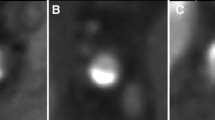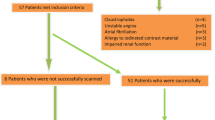Abstract
Objectives
Multi-detector-row computed tomography angiography (MDCTA) plays an important role in the assessment of patients with suspected coronary artery disease. However, MDCTA tends to overestimate stenosis in calcified coronary artery lesions. The aim of our study was to evaluate the diagnostic performance of calcification-suppressed material density (MD) images produced by using a single-detector single-source dual-energy computed tomography (ssDECT).
Methods
We enrolled 67 patients with suspected or known coronary artery disease who underwent ssDECT with rapid kilovolt-switching (80 and 140 kVp). Coronary artery stenosis was evaluated on the basis of MD images and virtual monochromatic (VM) images. The diagnostic performance of the two methods for detecting coronary artery disease was compared with that of invasive coronary angiography as a reference standard.
Results
We evaluated 239 calcified segments. In all the segments, the sensitivity, specificity, positive predictive value (PPV), negative predictive value (NPV) and accuracy for detecting significant stenosis were respectively 88%, 88%, 75%, 95% and 88% for the MD images, 91%, 71%, 56%, 95% and 77% for the VM images. PPV was significantly higher on the MD images than on the VM images (P < 0.0001).
Conclusions
Calcification-suppressed MD images improved PPV and diagnostic performance for calcified coronary artery lesions.
Key Points
• Computed tomography angiography tends to overestimate stenosis in calcified coronary artery.
• Dual-energy CT enables us to suppress calcification of coronary artery lesions.
• Calcification-suppressed material density imaging reduces false-positive diagnosis of calcified lesion.





Similar content being viewed by others
Abbreviations
- AUC:
-
Area under the receiver-operating characteristic curve
- CAD:
-
Coronary artery disease
- CCTA:
-
Coronary computed tomography angiography
- CT:
-
Computed tomography
- ICA:
-
Invasive coronary angiography
- MD:
-
Material density
- MDCTA:
-
Multi-detector-row computed tomography angiography
- QCA:
-
Quantitative coronary angiography
- ROC:
-
Receiver-operating characteristic
- ssDECT:
-
Single-detector single-source dual-energy computed tomography
- VM:
-
Virtual monochromatic
References
Cordeiro MA, Miller JM, Schmidt A et al (2006) Non-invasive half millimetre 32 detector row computed tomography angiography accurately excludes significant stenoses in patients with advanced coronary artery disease and high calcium scores. Heart 92:589–597
Hamon M, Morello R, Riddell JW, Hamon M (2007) Coronary arteries: diagnostic performance of 16- versus 64-section spiral CT compared with invasive coronary angiography—meta-analysis. Radiology 245:720–731
Meijboom WB, Meijs MF, Schuijf JD et al (2008) Diagnostic accuracy of 64-slice computed tomography coronary angiography: a prospective, multicenter, multivendor study. J Am Coll Cardiol 52:2135–2144
Zheng M, Wei M, Wen D et al (2015) Transluminal attenuation gradient in coronary computed tomography angiography for determining stenosis severity of calcified coronary artery: a primary study with dual-source CT. Eur Radiol 25:1219–1228
Zhang S, Levin DC, Halpern EJ, Fischman D, Savage M, Walinsky P (2008) Accuracy of MDCT in assessing the degree of stenosis caused by calcified coronary artery plaques. AJR Am J Roentgenol 191:1676–1683
Budoff MJ, Dowe D, Jollis JG et al (2008) Diagnostic performance of 64-multidetector row coronary computed tomographic angiography for evaluation of coronary artery stenosis in individuals without known coronary artery disease: results from the prospective multicenter ACCURACY (Assessment by Coronary Computed Tomographic Angiography of Individuals Undergoing Invasive Coronary Angiography) trial. J Am Coll Cardiol 52:1724–1732
Ong TK, Chin SP, Liew CK et al (2006) Accuracy of 64-row multidetector computed tomography in detecting coronary artery disease in 134 symptomatic patients: influence of calcification. Am Heart J 151:e1–e6
Gottlieb I, Miller JM, Arbab-Zadeh A et al (2010) The absence of coronary calcification does not exclude obstructive coronary artery disease or the need for revascularization in patients referred for conventional coronary angiography. J Am Coll Cardiol 55:627–634
Arbab-Zadeh A, Miller JM, Rochitte CE et al (2012) Diagnostic accuracy of computed tomography coronary angiography according to pre-test probability of coronary artery disease and severity of coronary arterial calcification. The CORE-64 (Coronary Artery Evaluation Using 64-Row Multidetector Computed Tomography Angiography) International Multicenter Study. J Am Coll Cardiol 59:379–387
Vavere AL, Arbab-Zadeh A, Rochitte CE et al (2011) Coronary artery stenoses: accuracy of 64-detector row CT angiography in segments with mild, moderate, or severe calcification—a subanalysis of the CORE-64 trial. Radiology 261:100–108
Yan RT, Miller JM, Rochitte CE et al (2013) Predictors of inaccurate coronary arterial stenosis assessment by CT angiography. J Am Coll Cardiol Img 6:963–972
Tanaka R, Yoshioka K, Muranaka K et al (2013) Improved evaluation of calcified segments on coronary CT angiography: a feasibility study of coronary calcium subtraction. Int J Cardiovasc Imaging 29:75–81
Danad I, Fayad ZA, Willemink MJ, Min JK (2015) New applications of cardiac computed tomography: dual energy, spectral, and molecular CT imaging. J Am Coll Cardiol Img 8:710–723
Vilades Medel D, Leta R, Alomar Serralach X, Carreras Costa F, Pons-Llado G (2016) Reliability of a new method for coronary artery calcium or metal subtraction by 320-row cardiac CT. Eur Radiol 26:3208–3214
Alvarez RE, Macovski A (1976) Energy-selective reconstructions in X-ray computerized tomography. Phys Med Biol 21:733–744
Silva AC, Morse BG, Hara AK, Paden RG, Hongo N, Pavlicek W (2011) Dual-energy (spectral) CT: applications in abdominal imaging. Radiographics 31:1031–1046
Pessis E, Campagna R, Sverzut JM et al (2013) Virtual monochromatic spectral imaging with fast kilovoltage switching: reduction of metal artifacts at CT. Radiographics 33:573–583
Hoffmann U, Kwait DC, Handwerker J, Chan R, Lamuraglia G, Brady TJ (2003) Vascular calcification in ex vivo carotid specimens: precision and accuracy of measurements with multi-detector row CT. Radiology 229:375–381
Matsumoto K, Jinzaki M, Tanami Y, Ueno A, Yamada M, Kuribayashi S (2011) Virtual monochromatic spectral imaging with fast kilovoltage switching: improved image quality as compared with that obtained with conventional 120-kVp CT. Radiology 259:257–262
Scheske JA, O'Brien JM, Earls JP et al (2013) Coronary artery imaging with single-source rapid kilovolt peak-switching dual-energy CT. Radiology 268:702–709
Leipsic J, Abbara S, Achenbach S et al (2014) SCCT guidelines for the interpretation and reporting of coronary CT angiography: a report of the Society of Cardiovascular Computed Tomography Guidelines Committee. J Cardiovasc Comput Tomogr 8:342–358
Hausleiter J, Meyer T, Hermann F et al (2009) Estimated radiation dose associated with cardiac CT angiography. JAMA 301:500–507
Zou KH, O'Malley AJ, Mauri L (2007) Receiver-operating characteristic analysis for evaluating diagnostic tests and predictive models. Circulation 115:654–657
Leisenring W, Alonzo T, Pepe MS (2000) Comparisons of predictive values of binary medical diagnostic tests for paired designs. Biometrics 56:345–351
DeLong ER, DeLong DM, Clarke-Pearson DL (1988) Comparing the areas under two or more correlated receiver operating characteristic curves: a nonparametric approach. Biometrics 44:837–845
Andreini D, Pontone G, Mushtaq S et al (2015) Diagnostic accuracy of rapid kilovolt peak-switching dual-energy CT coronary angiography in patients with a high calcium score. J Am Coll Cardiol Img 8:746–748
Fishbein GA, Micheletti RG, Currier JS, Singer E, Fishbein MC (2008) Atherosclerotic oxalosis in coronary arteries. Cardiovasc Pathol 17:117–123
Mannelli L, MacDonald L, Mancini M et al (2015) Dual energy computed tomography quantification of carotid plaques calcification: comparison between monochromatic and polychromatic energies with pathology correlation. Eur Radiol 25:1238–1246
Acknowledgements
The scientific guarantor of this publication is Toshihide Ogawa. The authors of this manuscript declare no relationships with any companies whose products or services may be related to the subject matter of the article. The authors state that this work has not received any funding. One of the authors has significant statistical expertise. Institutional review board approval was obtained. Written informed consent was obtained from all subjects (patients) in this study. All procedures performed in studies involving human participants were in accordance with the ethical standards of the institutional and/or national research committee and with the 1964 Declaration of Helsinki and its later amendments or comparable ethical standards. Methodology: retrospective, diagnostic or prognostic study, performed at one institution.
Author information
Authors and Affiliations
Corresponding author
Rights and permissions
About this article
Cite this article
Yunaga, H., Ohta, Y., Kaetsu, Y. et al. Diagnostic performance of calcification-suppressed coronary CT angiography using rapid kilovolt-switching dual-energy CT. Eur Radiol 27, 2794–2801 (2017). https://doi.org/10.1007/s00330-016-4675-x
Received:
Revised:
Accepted:
Published:
Issue Date:
DOI: https://doi.org/10.1007/s00330-016-4675-x




